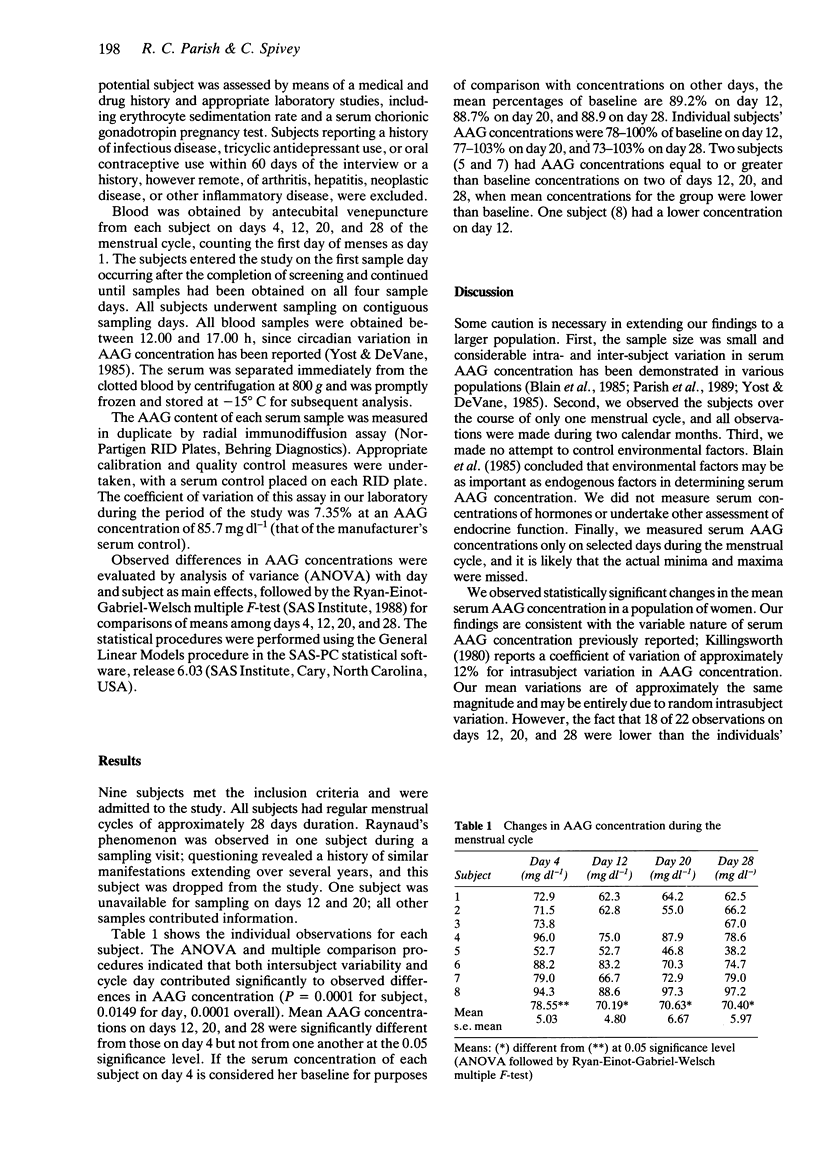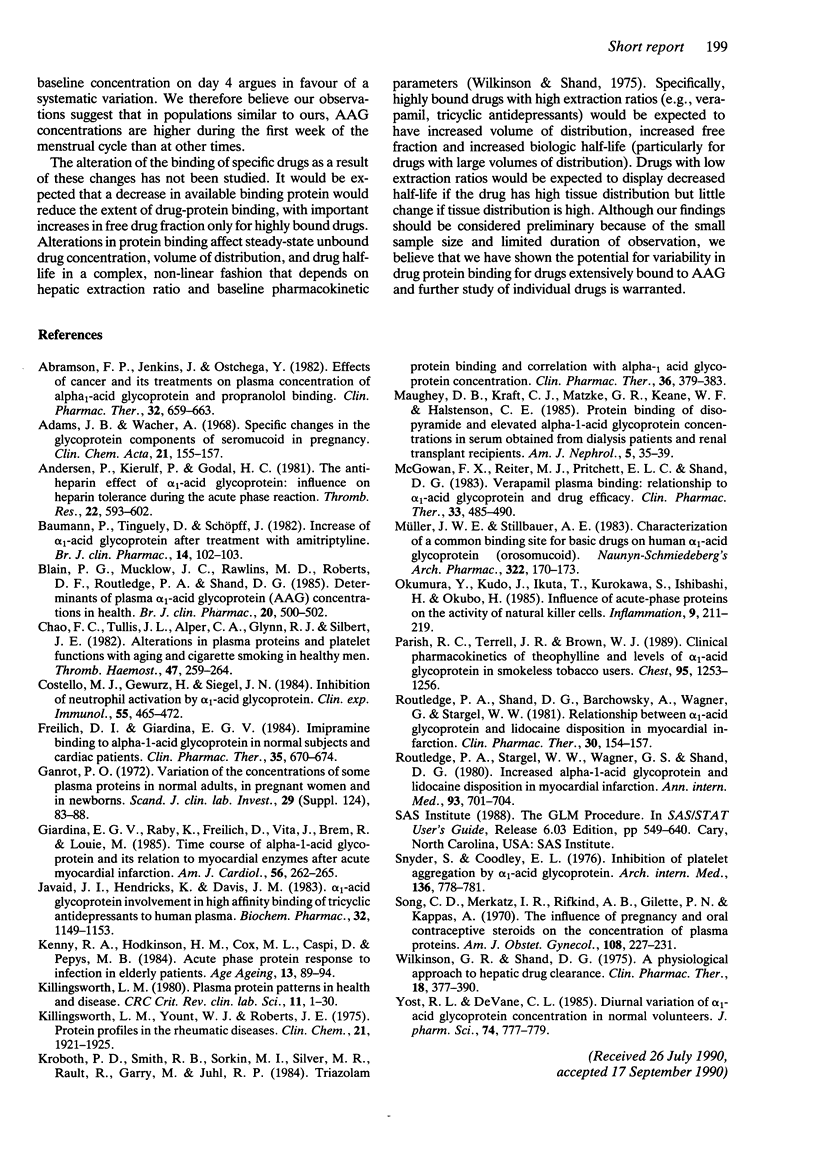Abstract
Serum concentrations of alpha 1-acid glycoprotein (AAG) were studied in nine healthy women at four times in their menstrual cycles. AAG concentrations were significantly higher on day 4 than on days 12, 20, and 28 (with the first day of menstrual flow considered to be day 1). The mean AAG concentration (mg dl-1) on day 4 was 78.55 +/- 5.03 (mean +/- s.e. mean), 70.19 +/- 4.80 on day 12, 70.63 +/- 6.67 on day 20, and 70.40 +/- 5.97 on day 28. Although these results should be considered preliminary because of the small sample size, we conclude that physiologic changes over the course of the menstrual cycle may affect serum AAG concentrations. Since AAG is a major binding protein for several important drugs, the potential exists for altered drug binding and drug effects, and further study of individual drugs is justified.
Full text
PDF


Selected References
These references are in PubMed. This may not be the complete list of references from this article.
- Abramson F. P., Jenkins J., Ostchega Y. Effects of cancer and its treatments on plasma concentration of alpha 1-acid glycoprotein and propranolol binding. Clin Pharmacol Ther. 1982 Nov;32(5):659–663. doi: 10.1038/clpt.1982.218. [DOI] [PubMed] [Google Scholar]
- Adams J. B., Wacher A. Specific changes in the glycoprotein components of seromucoid in pregnancy. Clin Chim Acta. 1968 Jul;21(1):155–157. doi: 10.1016/0009-8981(68)90024-7. [DOI] [PubMed] [Google Scholar]
- Andersen P., Kierulf P., Godal H. C. The antiheparin effect of alpha 1-acid glycoprotein: influence on heparin tolerance during the acute phase reaction. Thromb Res. 1981 Jun 1;22(5-6):593–602. doi: 10.1016/0049-3848(81)90058-x. [DOI] [PubMed] [Google Scholar]
- Baumann P., Tinguely D., Schöpf J. Increase of alpha 1-acid glycoprotein after treatment with amitriptyline. Br J Clin Pharmacol. 1982 Jul;14(1):102–103. doi: 10.1111/j.1365-2125.1982.tb04942.x. [DOI] [PMC free article] [PubMed] [Google Scholar]
- Blain P. G., Mucklow J. C., Rawlins M. D., Roberts D. F., Routledge P. A., Shand D. G. Determinants of plasma alpha 1-acid glycoprotein (AAG) concentrations in health. Br J Clin Pharmacol. 1985 Nov;20(5):500–502. doi: 10.1111/j.1365-2125.1985.tb05107.x. [DOI] [PMC free article] [PubMed] [Google Scholar]
- Chao F. C., Tullis J. L., Alper C. A., Glynn R. J., Silbert J. E. Alteration in plasma proteins and platelet functions with aging and cigarette smoking in healthy men. Thromb Haemost. 1982 Jun 28;47(3):259–264. [PubMed] [Google Scholar]
- Costello M. J., Gewurz H., Siegel J. N. Inhibition of neutrophil activation by alpha1-acid glycoprotein. Clin Exp Immunol. 1984 Feb;55(2):465–472. [PMC free article] [PubMed] [Google Scholar]
- Freilich D. I., Giardina E. G. Imipramine binding to alpha-1-acid glycoprotein in normal subjects and cardiac patients. Clin Pharmacol Ther. 1984 May;35(5):670–674. doi: 10.1038/clpt.1984.93. [DOI] [PubMed] [Google Scholar]
- Ganrot P. O. Variation of the concentrations of some plasma proteins in normal adults, in pregnant women and in newborns. Scand J Clin Lab Invest Suppl. 1972;124:83–88. doi: 10.3109/00365517209102755. [DOI] [PubMed] [Google Scholar]
- Giardina E. G., Raby K., Freilich D., Vita J., Brem R., Louie M. Time course of alpha-1-acid glycoprotein and its relation to myocardial enzymes after acute myocardial infarction. Am J Cardiol. 1985 Aug 1;56(4):262–265. doi: 10.1016/0002-9149(85)90846-x. [DOI] [PubMed] [Google Scholar]
- Haughey D. B., Kraft C. J., Matzke G. R., Keane W. F., Halstenson C. E. Protein binding of disopyramide and elevated alpha-1-acid glycoprotein concentrations in serum obtained from dialysis patients and renal transplant recipients. Am J Nephrol. 1985;5(1):35–39. doi: 10.1159/000166900. [DOI] [PubMed] [Google Scholar]
- Javaid J. I., Hendricks K., Davis J. M. alpha 1-acid glycoprotein involvement in high affinity binding of tricyclic antidepressants to human plasma. Biochem Pharmacol. 1983 Apr 1;32(7):1149–1153. doi: 10.1016/0006-2952(83)90263-0. [DOI] [PubMed] [Google Scholar]
- Kenny R. A., Hodkinson H. M., Cox M. L., Caspi D., Pepys M. B. Acute phase protein response to infection in elderly patients. Age Ageing. 1984 Mar;13(2):89–94. doi: 10.1093/ageing/13.2.89. [DOI] [PubMed] [Google Scholar]
- Killingsworth L. M. Plasma protein patterns in health and disease. CRC Crit Rev Clin Lab Sci. 1979 Aug;11(1):1–30. doi: 10.3109/10408367909105852. [DOI] [PubMed] [Google Scholar]
- Kroboth P. D., Smith R. B., Sorkin M. I., Silver M. R., Rault R., Garry M., Juhl R. P. Triazolam protein binding and correlation with alpha-1 acid glycoprotein concentration. Clin Pharmacol Ther. 1984 Sep;36(3):379–383. doi: 10.1038/clpt.1984.191. [DOI] [PubMed] [Google Scholar]
- McGowan F. X., Reiter M. J., Pritchett E. L., Shand D. G. Verapamil plasma binding: relationship to alpha 1-acid glycoprotein and drug efficacy. Clin Pharmacol Ther. 1983 Apr;33(4):485–490. doi: 10.1038/clpt.1983.66. [DOI] [PubMed] [Google Scholar]
- Müller W. E., Stillbauer A. E. Characterization of a common binding site for basic drugs on human alpha 1-acid glycoprotein (orosomucoid). Naunyn Schmiedebergs Arch Pharmacol. 1983 Mar;322(2):170–173. doi: 10.1007/BF00512392. [DOI] [PubMed] [Google Scholar]
- Okumura Y., Kudo J., Ikuta T., Kurokawa S., Ishibashi H., Okubo H. Influence of acute-phase proteins on the activity of natural killer cells. Inflammation. 1985 Jun;9(2):211–219. doi: 10.1007/BF00917593. [DOI] [PubMed] [Google Scholar]
- Parish R. C., Terrell J. R., Brown W. J., Jr Clinical pharmacokinetics of theophylline and levels of alpha 1-acid glycoprotein in smokeless tobacco users. Chest. 1989 Jun;95(6):1253–1256. doi: 10.1378/chest.95.6.1253. [DOI] [PubMed] [Google Scholar]
- Routledge P. A., Shand D. G., Barchowsky A., Wagner G., Stargel W. W. Relationship between alpha 1-acid glycoprotein and lidocaine disposition in myocardial infarction. Clin Pharmacol Ther. 1981 Aug;30(2):154–157. doi: 10.1038/clpt.1981.141. [DOI] [PubMed] [Google Scholar]
- Routledge P. A., Stargel W. W., Wagner G. S., Shand D. G. Increased alpha-1-acid glycoprotein and lidocaine disposition in myocardial infarction. Ann Intern Med. 1980 Nov;93(5):701–704. doi: 10.7326/0003-4819-93-5-701. [DOI] [PubMed] [Google Scholar]
- Snyder S., Coodley E. L. Inhibition of platelet aggregation by alpha1-acid glycoprotein. Arch Intern Med. 1976 Jul;136(7):778–781. [PubMed] [Google Scholar]
- Song C. S., Merkatz I. R., Rifkind A. B., Gillette P. N., Kappas A. The influence of pregnancy and oral contraceptive steroids on the concentration of plasma proteins. Studies with a quantitative immunodiffusion method. Am J Obstet Gynecol. 1970 Sep 15;108(2):227–231. doi: 10.1016/0002-9378(70)90301-7. [DOI] [PubMed] [Google Scholar]
- Wilkinson G. R., Shand D. G. Commentary: a physiological approach to hepatic drug clearance. Clin Pharmacol Ther. 1975 Oct;18(4):377–390. doi: 10.1002/cpt1975184377. [DOI] [PubMed] [Google Scholar]
- Yost R. L., DeVane C. L. Diurnal variation of alpha 1-acid glycoprotein concentration in normal volunteers. J Pharm Sci. 1985 Jul;74(7):777–779. doi: 10.1002/jps.2600740718. [DOI] [PubMed] [Google Scholar]


